HND Business Research Project: Equality and Diversity at Sainsbury
VerifiedAdded on 2023/01/13
|15
|3666
|24
Project
AI Summary
This business research project proposal examines the impact of behaviors on equality and diversity within the workplace, with a specific focus on Sainsbury. The research aims to identify behaviors that support equality and diversity, ultimately contributing to employee retention. The objectives include understanding the concept of equality and diversity, determining the significance of supportive behaviors, assessing current practices, and providing recommendations to Sainsbury. The research questions address the significance of behaviors and practices for managing equality and diversity. The project's rationale highlights the changing needs of employees and the importance of adapting company behaviors to promote inclusivity. The literature review explores concepts of equality and diversity, behaviors that support it, and the practices required for effective management. The methodology includes qualitative and quantitative research approaches using questionnaires, interpretivism, and inductive methods, sampling 20 managers. Data analysis will be done using a thematic approach. The project includes timelines, ethical considerations, and research methods. The project will conclude with findings and recommendations.
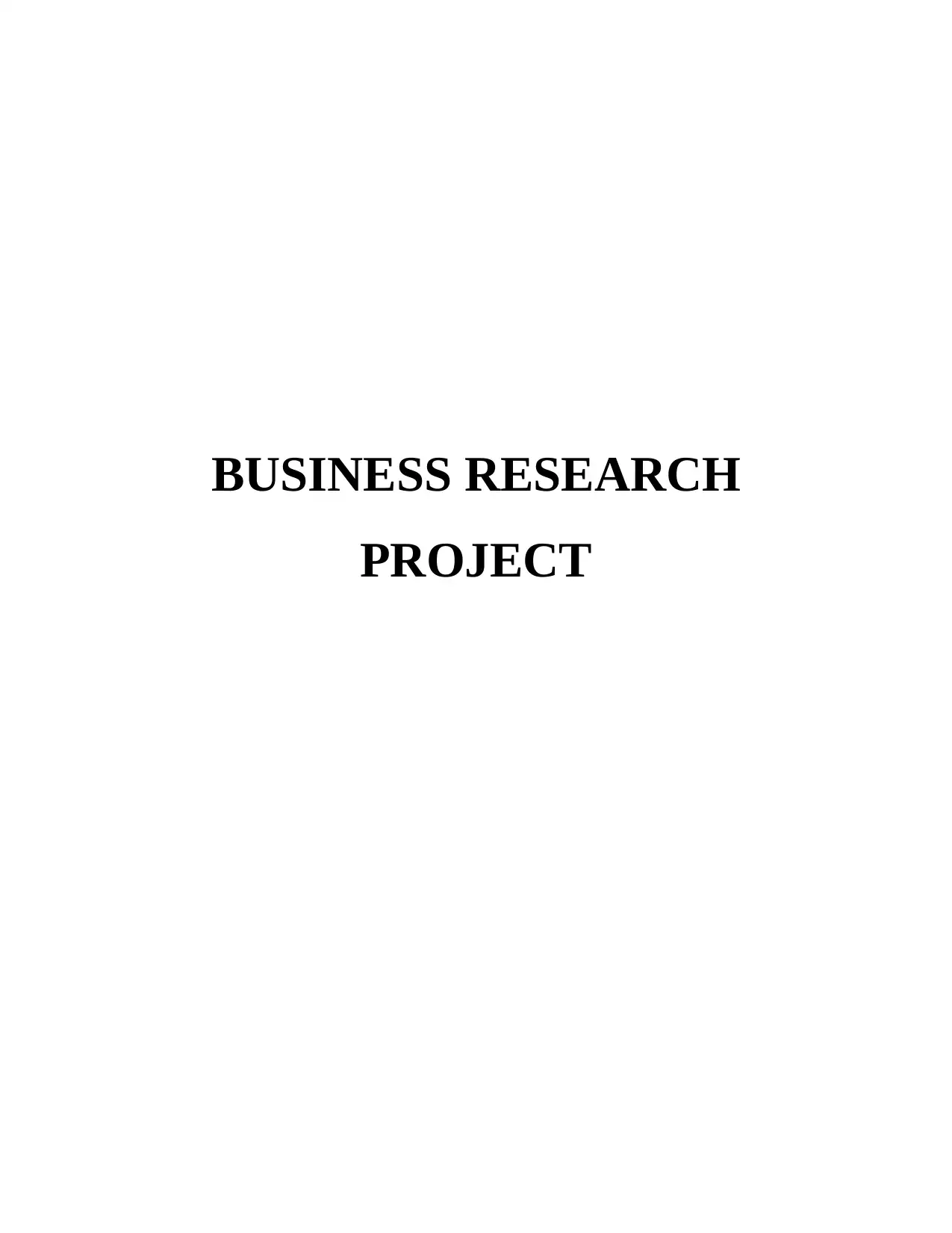
BUSINESS RESEARCH
PROJECT
PROJECT
Paraphrase This Document
Need a fresh take? Get an instant paraphrase of this document with our AI Paraphraser
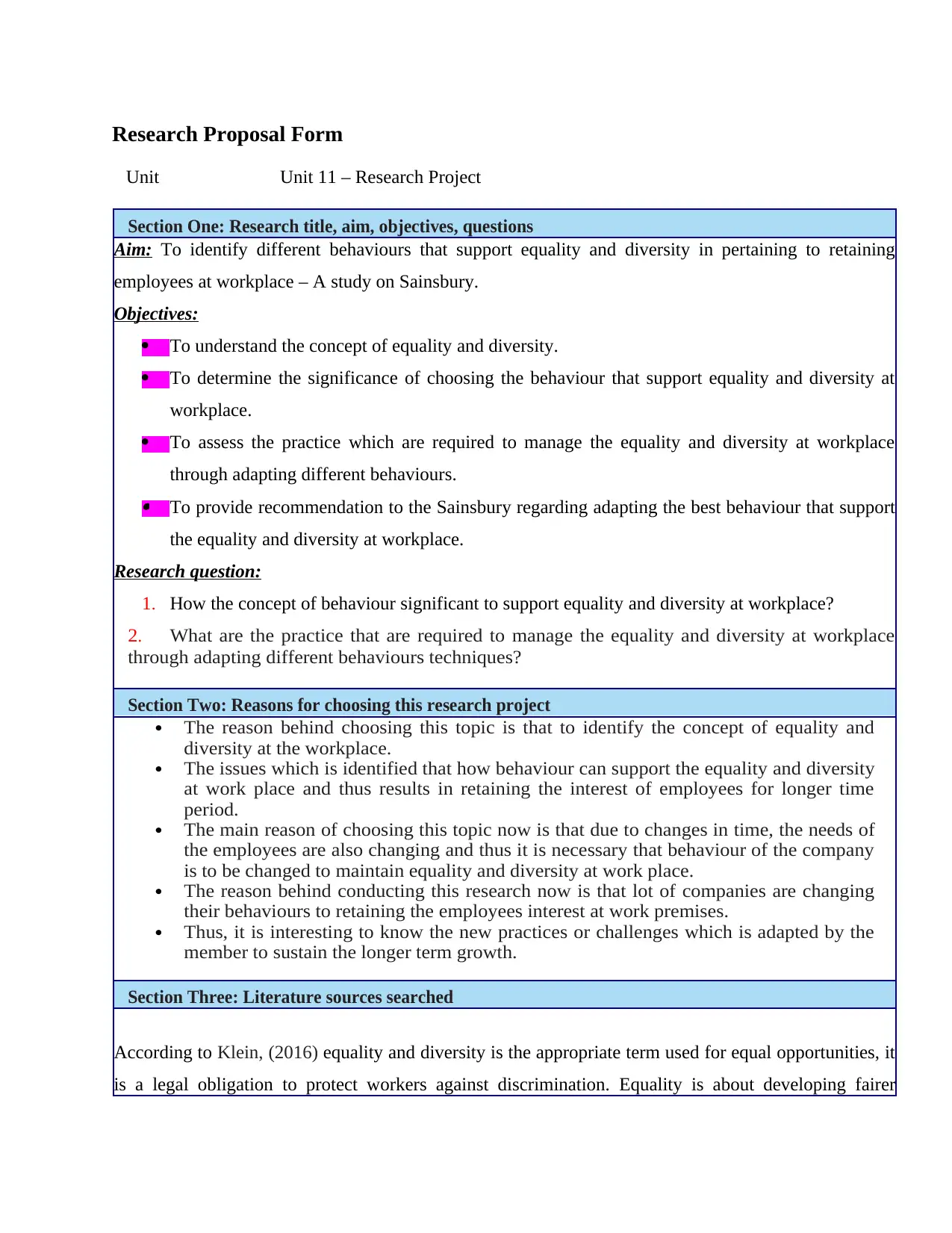
Research Proposal Form
Unit Unit 11 – Research Project
Section One: Research title, aim, objectives, questions
Aim: To identify different behaviours that support equality and diversity in pertaining to retaining
employees at workplace – A study on Sainsbury.
Objectives:
To understand the concept of equality and diversity.
To determine the significance of choosing the behaviour that support equality and diversity at
workplace.
To assess the practice which are required to manage the equality and diversity at workplace
through adapting different behaviours. To provide recommendation to the Sainsbury regarding adapting the best behaviour that support
the equality and diversity at workplace.
Research question:
1. How the concept of behaviour significant to support equality and diversity at workplace?
2. What are the practice that are required to manage the equality and diversity at workplace
through adapting different behaviours techniques?
Section Two: Reasons for choosing this research project
The reason behind choosing this topic is that to identify the concept of equality and
diversity at the workplace.
The issues which is identified that how behaviour can support the equality and diversity
at work place and thus results in retaining the interest of employees for longer time
period.
The main reason of choosing this topic now is that due to changes in time, the needs of
the employees are also changing and thus it is necessary that behaviour of the company
is to be changed to maintain equality and diversity at work place.
The reason behind conducting this research now is that lot of companies are changing
their behaviours to retaining the employees interest at work premises.
Thus, it is interesting to know the new practices or challenges which is adapted by the
member to sustain the longer term growth.
Section Three: Literature sources searched
According to Klein, (2016) equality and diversity is the appropriate term used for equal opportunities, it
is a legal obligation to protect workers against discrimination. Equality is about developing fairer
Unit Unit 11 – Research Project
Section One: Research title, aim, objectives, questions
Aim: To identify different behaviours that support equality and diversity in pertaining to retaining
employees at workplace – A study on Sainsbury.
Objectives:
To understand the concept of equality and diversity.
To determine the significance of choosing the behaviour that support equality and diversity at
workplace.
To assess the practice which are required to manage the equality and diversity at workplace
through adapting different behaviours. To provide recommendation to the Sainsbury regarding adapting the best behaviour that support
the equality and diversity at workplace.
Research question:
1. How the concept of behaviour significant to support equality and diversity at workplace?
2. What are the practice that are required to manage the equality and diversity at workplace
through adapting different behaviours techniques?
Section Two: Reasons for choosing this research project
The reason behind choosing this topic is that to identify the concept of equality and
diversity at the workplace.
The issues which is identified that how behaviour can support the equality and diversity
at work place and thus results in retaining the interest of employees for longer time
period.
The main reason of choosing this topic now is that due to changes in time, the needs of
the employees are also changing and thus it is necessary that behaviour of the company
is to be changed to maintain equality and diversity at work place.
The reason behind conducting this research now is that lot of companies are changing
their behaviours to retaining the employees interest at work premises.
Thus, it is interesting to know the new practices or challenges which is adapted by the
member to sustain the longer term growth.
Section Three: Literature sources searched
According to Klein, (2016) equality and diversity is the appropriate term used for equal opportunities, it
is a legal obligation to protect workers against discrimination. Equality is about developing fairer
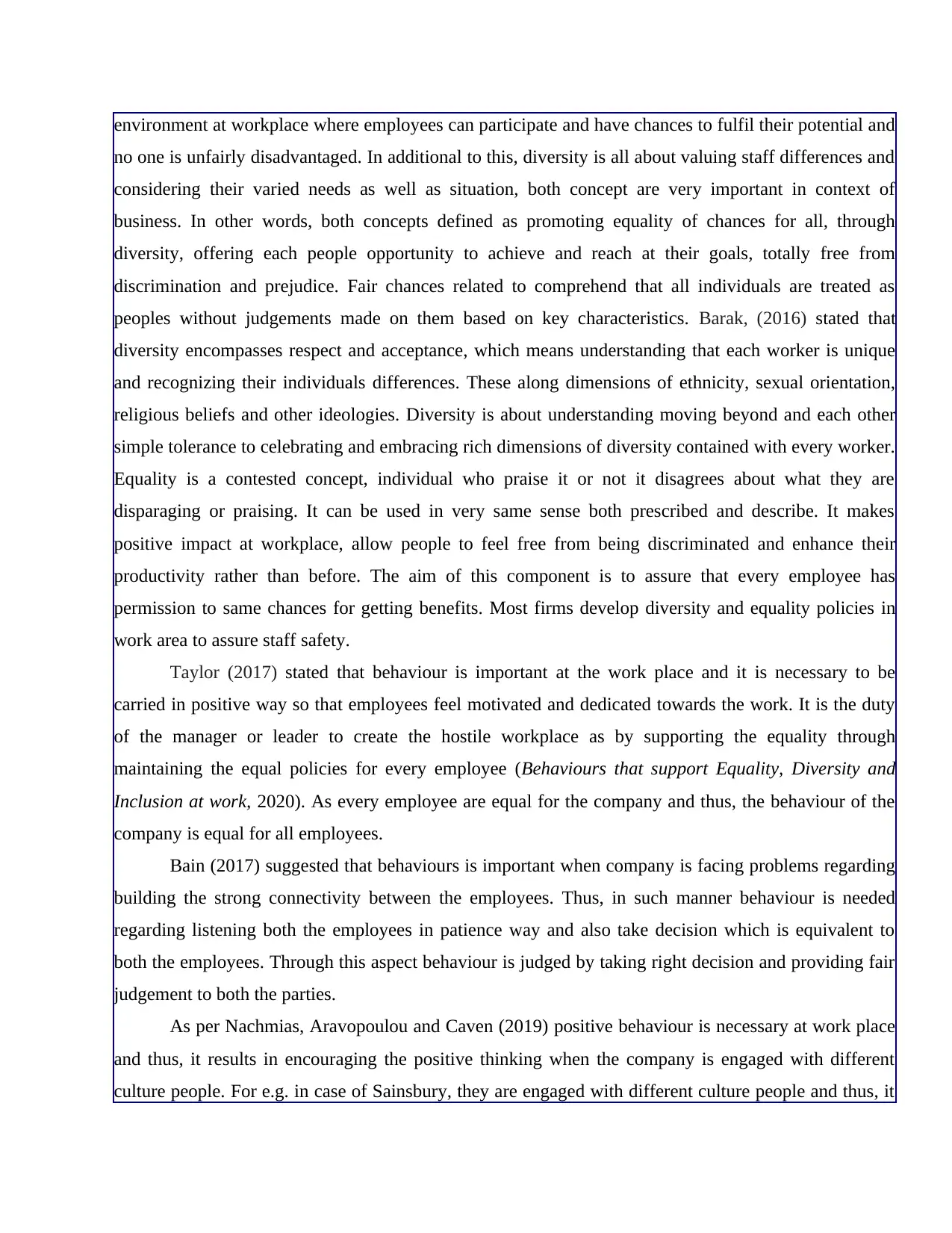
environment at workplace where employees can participate and have chances to fulfil their potential and
no one is unfairly disadvantaged. In additional to this, diversity is all about valuing staff differences and
considering their varied needs as well as situation, both concept are very important in context of
business. In other words, both concepts defined as promoting equality of chances for all, through
diversity, offering each people opportunity to achieve and reach at their goals, totally free from
discrimination and prejudice. Fair chances related to comprehend that all individuals are treated as
peoples without judgements made on them based on key characteristics. Barak, (2016) stated that
diversity encompasses respect and acceptance, which means understanding that each worker is unique
and recognizing their individuals differences. These along dimensions of ethnicity, sexual orientation,
religious beliefs and other ideologies. Diversity is about understanding moving beyond and each other
simple tolerance to celebrating and embracing rich dimensions of diversity contained with every worker.
Equality is a contested concept, individual who praise it or not it disagrees about what they are
disparaging or praising. It can be used in very same sense both prescribed and describe. It makes
positive impact at workplace, allow people to feel free from being discriminated and enhance their
productivity rather than before. The aim of this component is to assure that every employee has
permission to same chances for getting benefits. Most firms develop diversity and equality policies in
work area to assure staff safety.
Taylor (2017) stated that behaviour is important at the work place and it is necessary to be
carried in positive way so that employees feel motivated and dedicated towards the work. It is the duty
of the manager or leader to create the hostile workplace as by supporting the equality through
maintaining the equal policies for every employee (Behaviours that support Equality, Diversity and
Inclusion at work, 2020). As every employee are equal for the company and thus, the behaviour of the
company is equal for all employees.
Bain (2017) suggested that behaviours is important when company is facing problems regarding
building the strong connectivity between the employees. Thus, in such manner behaviour is needed
regarding listening both the employees in patience way and also take decision which is equivalent to
both the employees. Through this aspect behaviour is judged by taking right decision and providing fair
judgement to both the parties.
As per Nachmias, Aravopoulou and Caven (2019) positive behaviour is necessary at work place
and thus, it results in encouraging the positive thinking when the company is engaged with different
culture people. For e.g. in case of Sainsbury, they are engaged with different culture people and thus, it
no one is unfairly disadvantaged. In additional to this, diversity is all about valuing staff differences and
considering their varied needs as well as situation, both concept are very important in context of
business. In other words, both concepts defined as promoting equality of chances for all, through
diversity, offering each people opportunity to achieve and reach at their goals, totally free from
discrimination and prejudice. Fair chances related to comprehend that all individuals are treated as
peoples without judgements made on them based on key characteristics. Barak, (2016) stated that
diversity encompasses respect and acceptance, which means understanding that each worker is unique
and recognizing their individuals differences. These along dimensions of ethnicity, sexual orientation,
religious beliefs and other ideologies. Diversity is about understanding moving beyond and each other
simple tolerance to celebrating and embracing rich dimensions of diversity contained with every worker.
Equality is a contested concept, individual who praise it or not it disagrees about what they are
disparaging or praising. It can be used in very same sense both prescribed and describe. It makes
positive impact at workplace, allow people to feel free from being discriminated and enhance their
productivity rather than before. The aim of this component is to assure that every employee has
permission to same chances for getting benefits. Most firms develop diversity and equality policies in
work area to assure staff safety.
Taylor (2017) stated that behaviour is important at the work place and it is necessary to be
carried in positive way so that employees feel motivated and dedicated towards the work. It is the duty
of the manager or leader to create the hostile workplace as by supporting the equality through
maintaining the equal policies for every employee (Behaviours that support Equality, Diversity and
Inclusion at work, 2020). As every employee are equal for the company and thus, the behaviour of the
company is equal for all employees.
Bain (2017) suggested that behaviours is important when company is facing problems regarding
building the strong connectivity between the employees. Thus, in such manner behaviour is needed
regarding listening both the employees in patience way and also take decision which is equivalent to
both the employees. Through this aspect behaviour is judged by taking right decision and providing fair
judgement to both the parties.
As per Nachmias, Aravopoulou and Caven (2019) positive behaviour is necessary at work place
and thus, it results in encouraging the positive thinking when the company is engaged with different
culture people. For e.g. in case of Sainsbury, they are engaged with different culture people and thus, it
⊘ This is a preview!⊘
Do you want full access?
Subscribe today to unlock all pages.

Trusted by 1+ million students worldwide
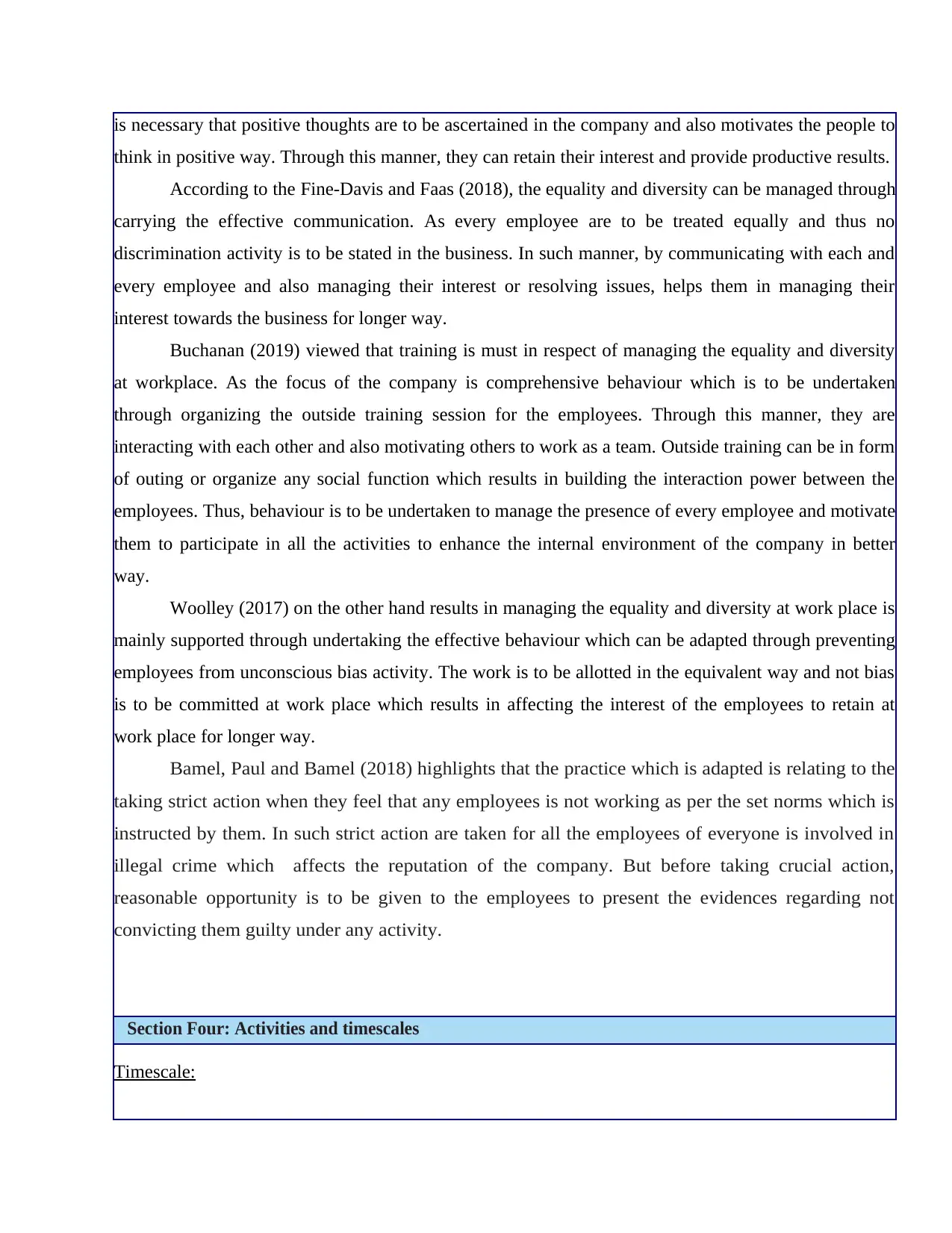
is necessary that positive thoughts are to be ascertained in the company and also motivates the people to
think in positive way. Through this manner, they can retain their interest and provide productive results.
According to the Fine-Davis and Faas (2018), the equality and diversity can be managed through
carrying the effective communication. As every employee are to be treated equally and thus no
discrimination activity is to be stated in the business. In such manner, by communicating with each and
every employee and also managing their interest or resolving issues, helps them in managing their
interest towards the business for longer way.
Buchanan (2019) viewed that training is must in respect of managing the equality and diversity
at workplace. As the focus of the company is comprehensive behaviour which is to be undertaken
through organizing the outside training session for the employees. Through this manner, they are
interacting with each other and also motivating others to work as a team. Outside training can be in form
of outing or organize any social function which results in building the interaction power between the
employees. Thus, behaviour is to be undertaken to manage the presence of every employee and motivate
them to participate in all the activities to enhance the internal environment of the company in better
way.
Woolley (2017) on the other hand results in managing the equality and diversity at work place is
mainly supported through undertaking the effective behaviour which can be adapted through preventing
employees from unconscious bias activity. The work is to be allotted in the equivalent way and not bias
is to be committed at work place which results in affecting the interest of the employees to retain at
work place for longer way.
Bamel, Paul and Bamel (2018) highlights that the practice which is adapted is relating to the
taking strict action when they feel that any employees is not working as per the set norms which is
instructed by them. In such strict action are taken for all the employees of everyone is involved in
illegal crime which affects the reputation of the company. But before taking crucial action,
reasonable opportunity is to be given to the employees to present the evidences regarding not
convicting them guilty under any activity.
Section Four: Activities and timescales
Timescale:
think in positive way. Through this manner, they can retain their interest and provide productive results.
According to the Fine-Davis and Faas (2018), the equality and diversity can be managed through
carrying the effective communication. As every employee are to be treated equally and thus no
discrimination activity is to be stated in the business. In such manner, by communicating with each and
every employee and also managing their interest or resolving issues, helps them in managing their
interest towards the business for longer way.
Buchanan (2019) viewed that training is must in respect of managing the equality and diversity
at workplace. As the focus of the company is comprehensive behaviour which is to be undertaken
through organizing the outside training session for the employees. Through this manner, they are
interacting with each other and also motivating others to work as a team. Outside training can be in form
of outing or organize any social function which results in building the interaction power between the
employees. Thus, behaviour is to be undertaken to manage the presence of every employee and motivate
them to participate in all the activities to enhance the internal environment of the company in better
way.
Woolley (2017) on the other hand results in managing the equality and diversity at work place is
mainly supported through undertaking the effective behaviour which can be adapted through preventing
employees from unconscious bias activity. The work is to be allotted in the equivalent way and not bias
is to be committed at work place which results in affecting the interest of the employees to retain at
work place for longer way.
Bamel, Paul and Bamel (2018) highlights that the practice which is adapted is relating to the
taking strict action when they feel that any employees is not working as per the set norms which is
instructed by them. In such strict action are taken for all the employees of everyone is involved in
illegal crime which affects the reputation of the company. But before taking crucial action,
reasonable opportunity is to be given to the employees to present the evidences regarding not
convicting them guilty under any activity.
Section Four: Activities and timescales
Timescale:
Paraphrase This Document
Need a fresh take? Get an instant paraphrase of this document with our AI Paraphraser
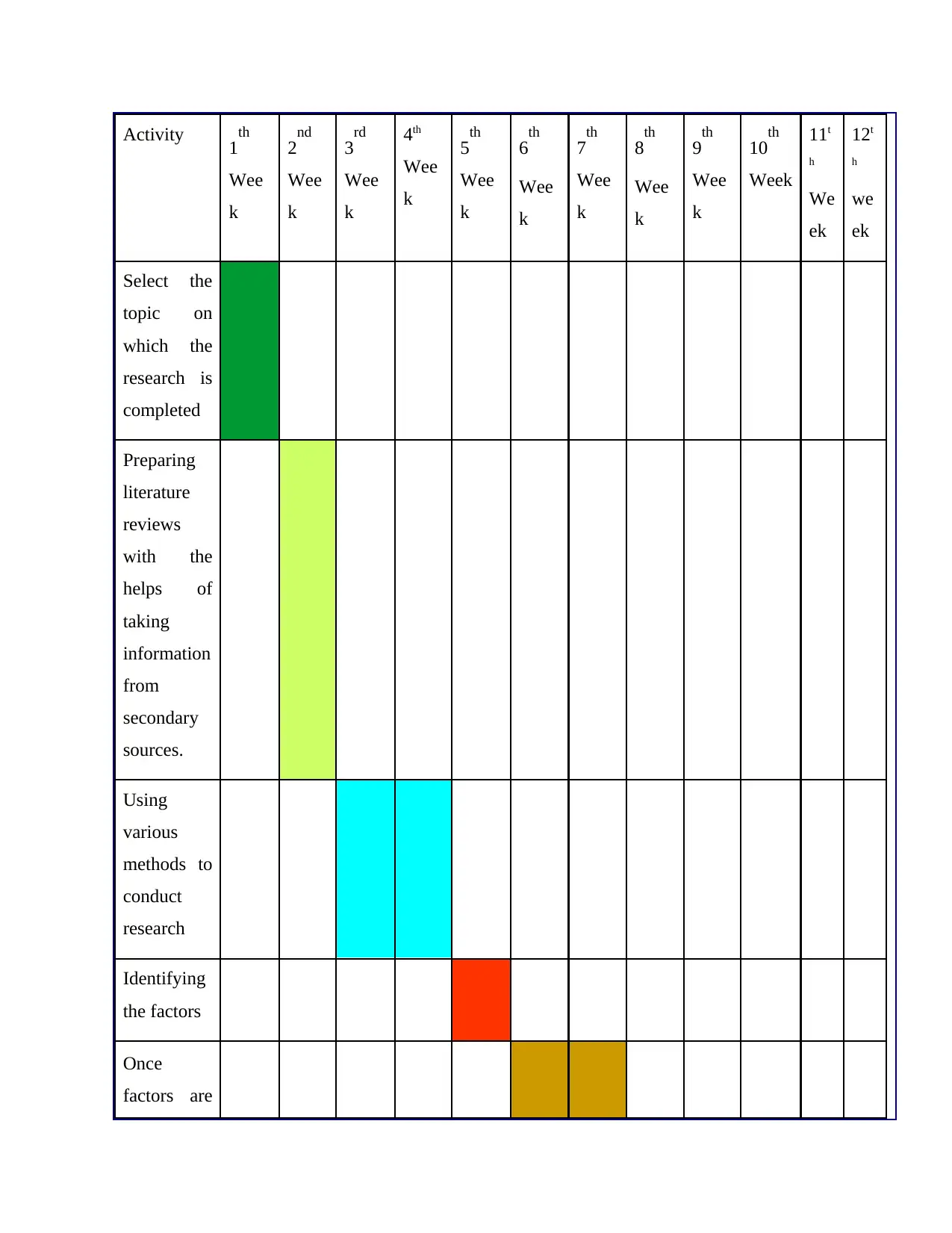
Activity 1th
Wee
k
2nd
Wee
k
3rd
Wee
k
4th
Wee
k
5th
Wee
k
6th
Wee
k
7th
Wee
k
8th
Wee
k
9th
Wee
k
10th
Week
11t
h
We
ek
12t
h
we
ek
Select the
topic on
which the
research is
completed
Preparing
literature
reviews
with the
helps of
taking
information
from
secondary
sources.
Using
various
methods to
conduct
research
Identifying
the factors
Once
factors are
Wee
k
2nd
Wee
k
3rd
Wee
k
4th
Wee
k
5th
Wee
k
6th
Wee
k
7th
Wee
k
8th
Wee
k
9th
Wee
k
10th
Week
11t
h
We
ek
12t
h
we
ek
Select the
topic on
which the
research is
completed
Preparing
literature
reviews
with the
helps of
taking
information
from
secondary
sources.
Using
various
methods to
conduct
research
Identifying
the factors
Once
factors are
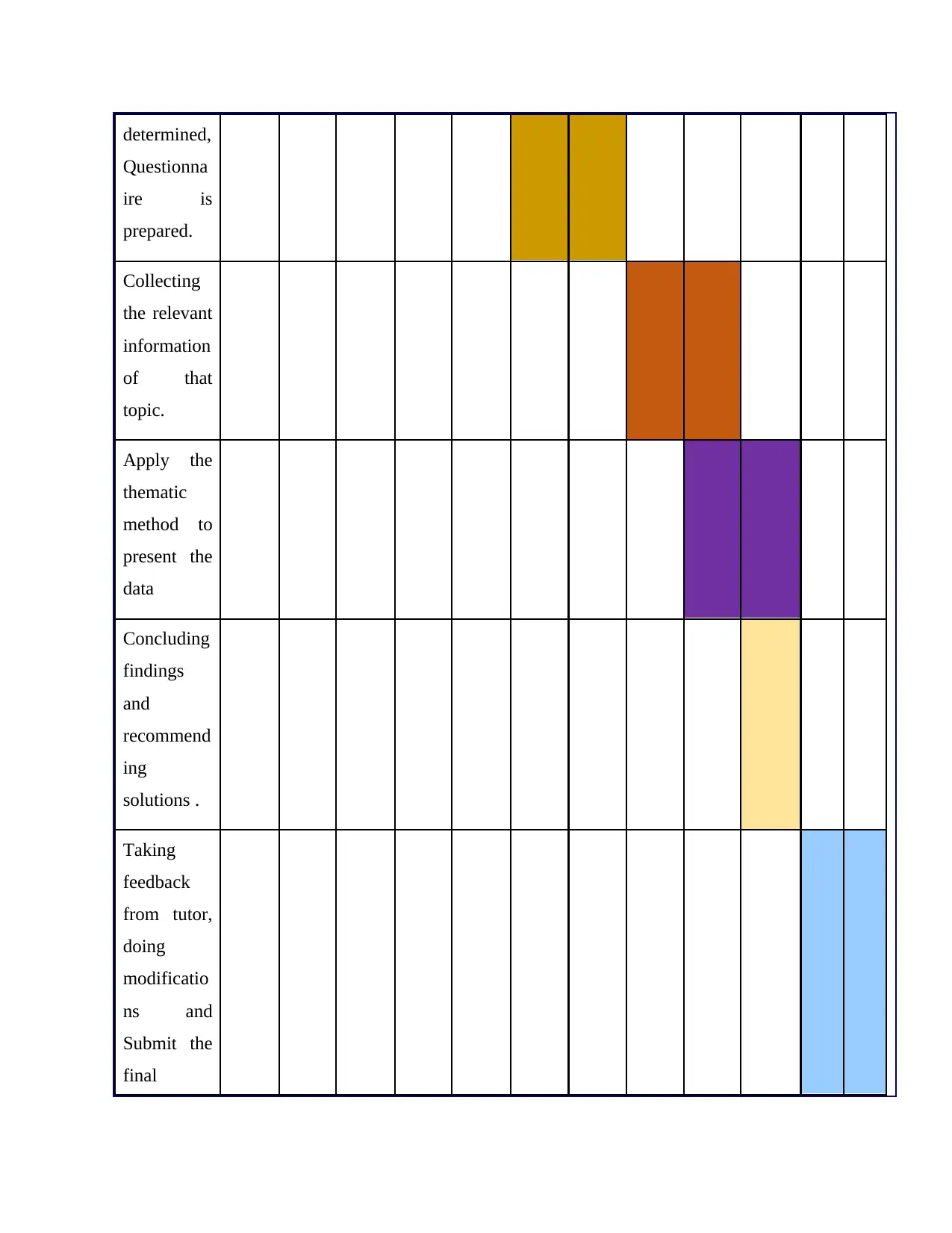
determined,
Questionna
ire is
prepared.
Collecting
the relevant
information
of that
topic.
Apply the
thematic
method to
present the
data
Concluding
findings
and
recommend
ing
solutions .
Taking
feedback
from tutor,
doing
modificatio
ns and
Submit the
final
Questionna
ire is
prepared.
Collecting
the relevant
information
of that
topic.
Apply the
thematic
method to
present the
data
Concluding
findings
and
recommend
ing
solutions .
Taking
feedback
from tutor,
doing
modificatio
ns and
Submit the
final
⊘ This is a preview!⊘
Do you want full access?
Subscribe today to unlock all pages.

Trusted by 1+ million students worldwide
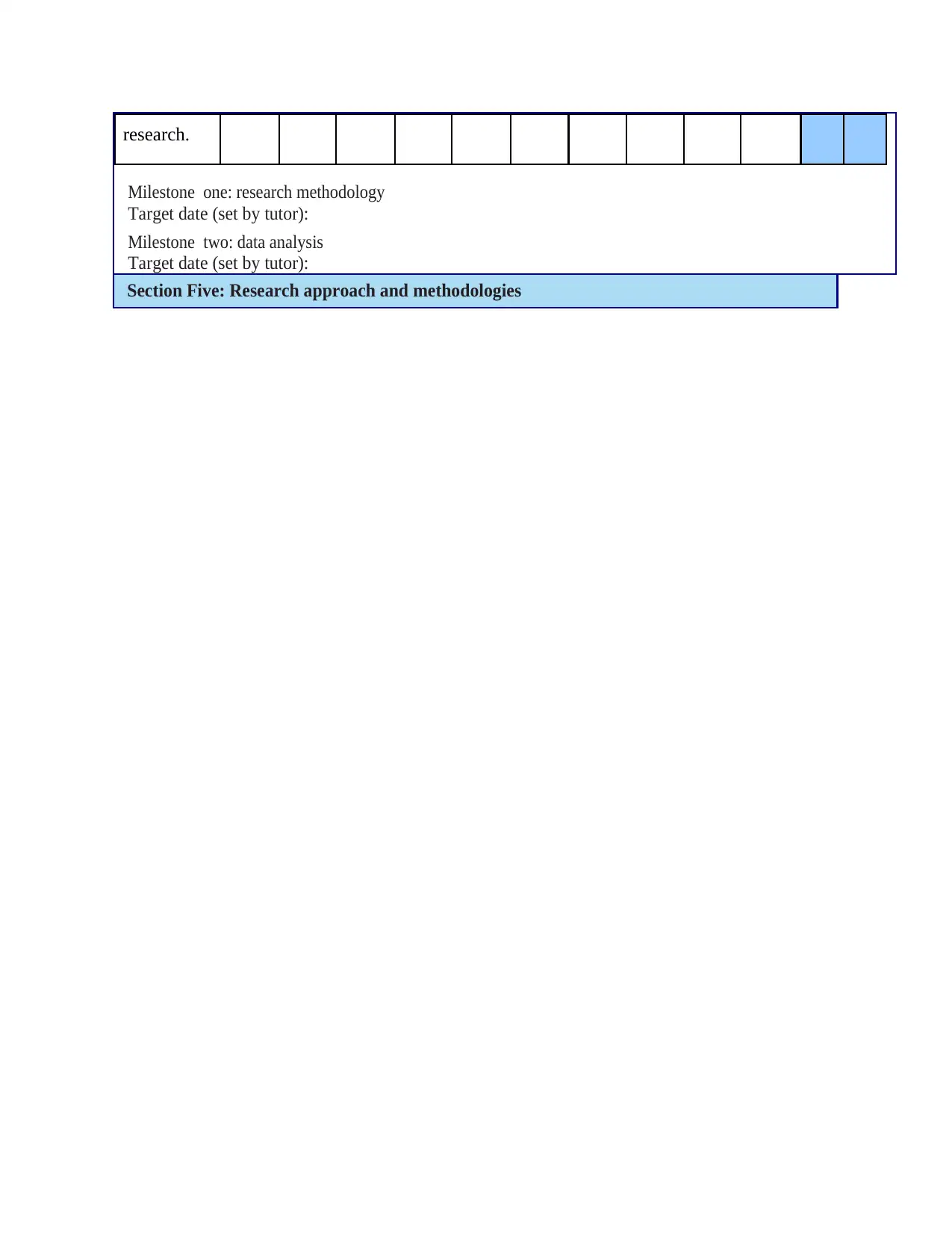
research.
Milestone one: research methodology
Target date (set by tutor):
Milestone two: data analysis
Target date (set by tutor):
Section Five: Research approach and methodologies
Milestone one: research methodology
Target date (set by tutor):
Milestone two: data analysis
Target date (set by tutor):
Section Five: Research approach and methodologies
Paraphrase This Document
Need a fresh take? Get an instant paraphrase of this document with our AI Paraphraser
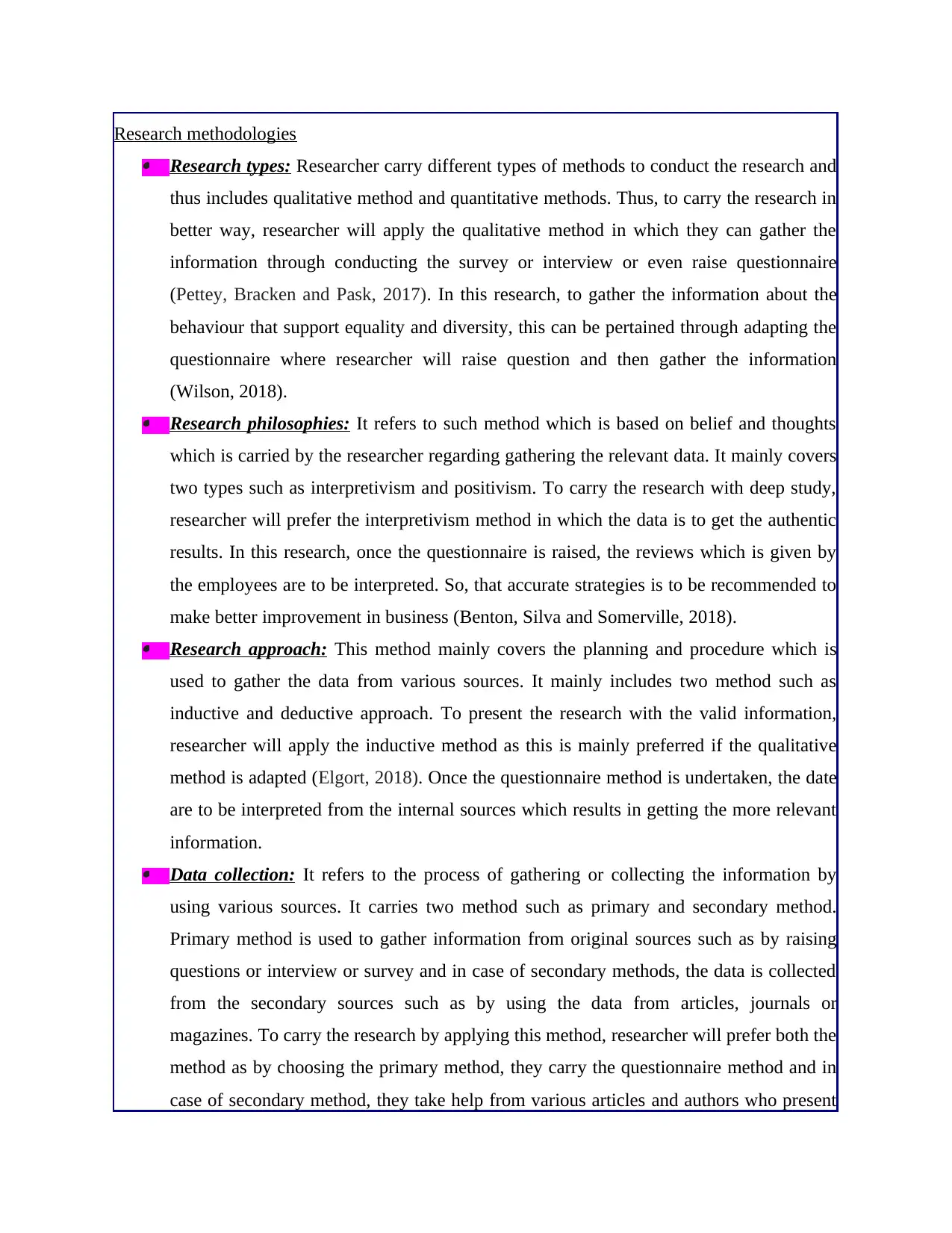
Research methodologies Research types: Researcher carry different types of methods to conduct the research and
thus includes qualitative method and quantitative methods. Thus, to carry the research in
better way, researcher will apply the qualitative method in which they can gather the
information through conducting the survey or interview or even raise questionnaire
(Pettey, Bracken and Pask, 2017). In this research, to gather the information about the
behaviour that support equality and diversity, this can be pertained through adapting the
questionnaire where researcher will raise question and then gather the information
(Wilson, 2018). Research philosophies: It refers to such method which is based on belief and thoughts
which is carried by the researcher regarding gathering the relevant data. It mainly covers
two types such as interpretivism and positivism. To carry the research with deep study,
researcher will prefer the interpretivism method in which the data is to get the authentic
results. In this research, once the questionnaire is raised, the reviews which is given by
the employees are to be interpreted. So, that accurate strategies is to be recommended to
make better improvement in business (Benton, Silva and Somerville, 2018). Research approach: This method mainly covers the planning and procedure which is
used to gather the data from various sources. It mainly includes two method such as
inductive and deductive approach. To present the research with the valid information,
researcher will apply the inductive method as this is mainly preferred if the qualitative
method is adapted (Elgort, 2018). Once the questionnaire method is undertaken, the date
are to be interpreted from the internal sources which results in getting the more relevant
information. Data collection: It refers to the process of gathering or collecting the information by
using various sources. It carries two method such as primary and secondary method.
Primary method is used to gather information from original sources such as by raising
questions or interview or survey and in case of secondary methods, the data is collected
from the secondary sources such as by using the data from articles, journals or
magazines. To carry the research by applying this method, researcher will prefer both the
method as by choosing the primary method, they carry the questionnaire method and in
case of secondary method, they take help from various articles and authors who present
thus includes qualitative method and quantitative methods. Thus, to carry the research in
better way, researcher will apply the qualitative method in which they can gather the
information through conducting the survey or interview or even raise questionnaire
(Pettey, Bracken and Pask, 2017). In this research, to gather the information about the
behaviour that support equality and diversity, this can be pertained through adapting the
questionnaire where researcher will raise question and then gather the information
(Wilson, 2018). Research philosophies: It refers to such method which is based on belief and thoughts
which is carried by the researcher regarding gathering the relevant data. It mainly covers
two types such as interpretivism and positivism. To carry the research with deep study,
researcher will prefer the interpretivism method in which the data is to get the authentic
results. In this research, once the questionnaire is raised, the reviews which is given by
the employees are to be interpreted. So, that accurate strategies is to be recommended to
make better improvement in business (Benton, Silva and Somerville, 2018). Research approach: This method mainly covers the planning and procedure which is
used to gather the data from various sources. It mainly includes two method such as
inductive and deductive approach. To present the research with the valid information,
researcher will apply the inductive method as this is mainly preferred if the qualitative
method is adapted (Elgort, 2018). Once the questionnaire method is undertaken, the date
are to be interpreted from the internal sources which results in getting the more relevant
information. Data collection: It refers to the process of gathering or collecting the information by
using various sources. It carries two method such as primary and secondary method.
Primary method is used to gather information from original sources such as by raising
questions or interview or survey and in case of secondary methods, the data is collected
from the secondary sources such as by using the data from articles, journals or
magazines. To carry the research by applying this method, researcher will prefer both the
method as by choosing the primary method, they carry the questionnaire method and in
case of secondary method, they take help from various articles and authors who present
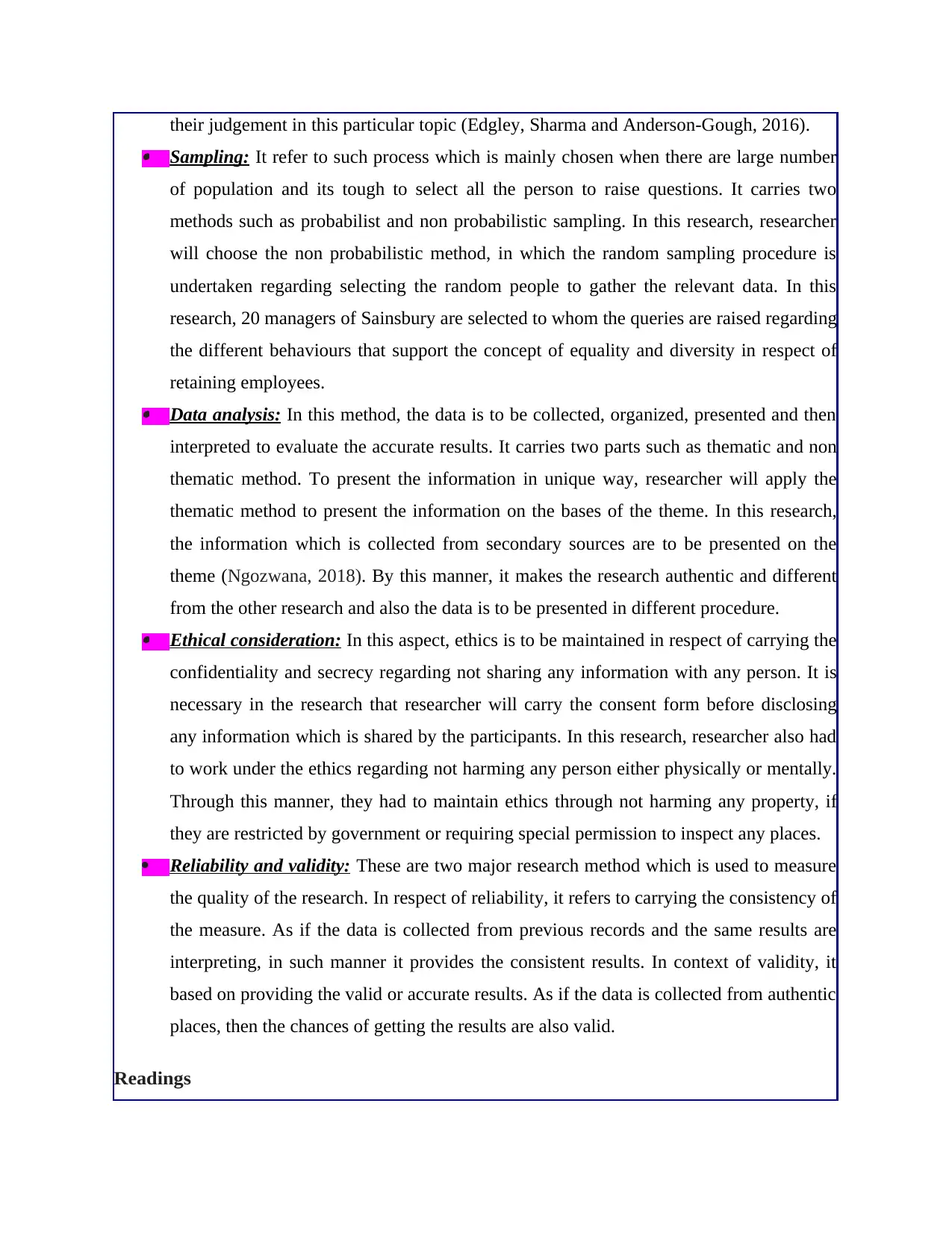
their judgement in this particular topic (Edgley, Sharma and Anderson-Gough, 2016). Sampling: It refer to such process which is mainly chosen when there are large number
of population and its tough to select all the person to raise questions. It carries two
methods such as probabilist and non probabilistic sampling. In this research, researcher
will choose the non probabilistic method, in which the random sampling procedure is
undertaken regarding selecting the random people to gather the relevant data. In this
research, 20 managers of Sainsbury are selected to whom the queries are raised regarding
the different behaviours that support the concept of equality and diversity in respect of
retaining employees. Data analysis: In this method, the data is to be collected, organized, presented and then
interpreted to evaluate the accurate results. It carries two parts such as thematic and non
thematic method. To present the information in unique way, researcher will apply the
thematic method to present the information on the bases of the theme. In this research,
the information which is collected from secondary sources are to be presented on the
theme (Ngozwana, 2018). By this manner, it makes the research authentic and different
from the other research and also the data is to be presented in different procedure. Ethical consideration: In this aspect, ethics is to be maintained in respect of carrying the
confidentiality and secrecy regarding not sharing any information with any person. It is
necessary in the research that researcher will carry the consent form before disclosing
any information which is shared by the participants. In this research, researcher also had
to work under the ethics regarding not harming any person either physically or mentally.
Through this manner, they had to maintain ethics through not harming any property, if
they are restricted by government or requiring special permission to inspect any places.
Reliability and validity: These are two major research method which is used to measure
the quality of the research. In respect of reliability, it refers to carrying the consistency of
the measure. As if the data is collected from previous records and the same results are
interpreting, in such manner it provides the consistent results. In context of validity, it
based on providing the valid or accurate results. As if the data is collected from authentic
places, then the chances of getting the results are also valid.
Readings
of population and its tough to select all the person to raise questions. It carries two
methods such as probabilist and non probabilistic sampling. In this research, researcher
will choose the non probabilistic method, in which the random sampling procedure is
undertaken regarding selecting the random people to gather the relevant data. In this
research, 20 managers of Sainsbury are selected to whom the queries are raised regarding
the different behaviours that support the concept of equality and diversity in respect of
retaining employees. Data analysis: In this method, the data is to be collected, organized, presented and then
interpreted to evaluate the accurate results. It carries two parts such as thematic and non
thematic method. To present the information in unique way, researcher will apply the
thematic method to present the information on the bases of the theme. In this research,
the information which is collected from secondary sources are to be presented on the
theme (Ngozwana, 2018). By this manner, it makes the research authentic and different
from the other research and also the data is to be presented in different procedure. Ethical consideration: In this aspect, ethics is to be maintained in respect of carrying the
confidentiality and secrecy regarding not sharing any information with any person. It is
necessary in the research that researcher will carry the consent form before disclosing
any information which is shared by the participants. In this research, researcher also had
to work under the ethics regarding not harming any person either physically or mentally.
Through this manner, they had to maintain ethics through not harming any property, if
they are restricted by government or requiring special permission to inspect any places.
Reliability and validity: These are two major research method which is used to measure
the quality of the research. In respect of reliability, it refers to carrying the consistency of
the measure. As if the data is collected from previous records and the same results are
interpreting, in such manner it provides the consistent results. In context of validity, it
based on providing the valid or accurate results. As if the data is collected from authentic
places, then the chances of getting the results are also valid.
Readings
⊘ This is a preview!⊘
Do you want full access?
Subscribe today to unlock all pages.

Trusted by 1+ million students worldwide
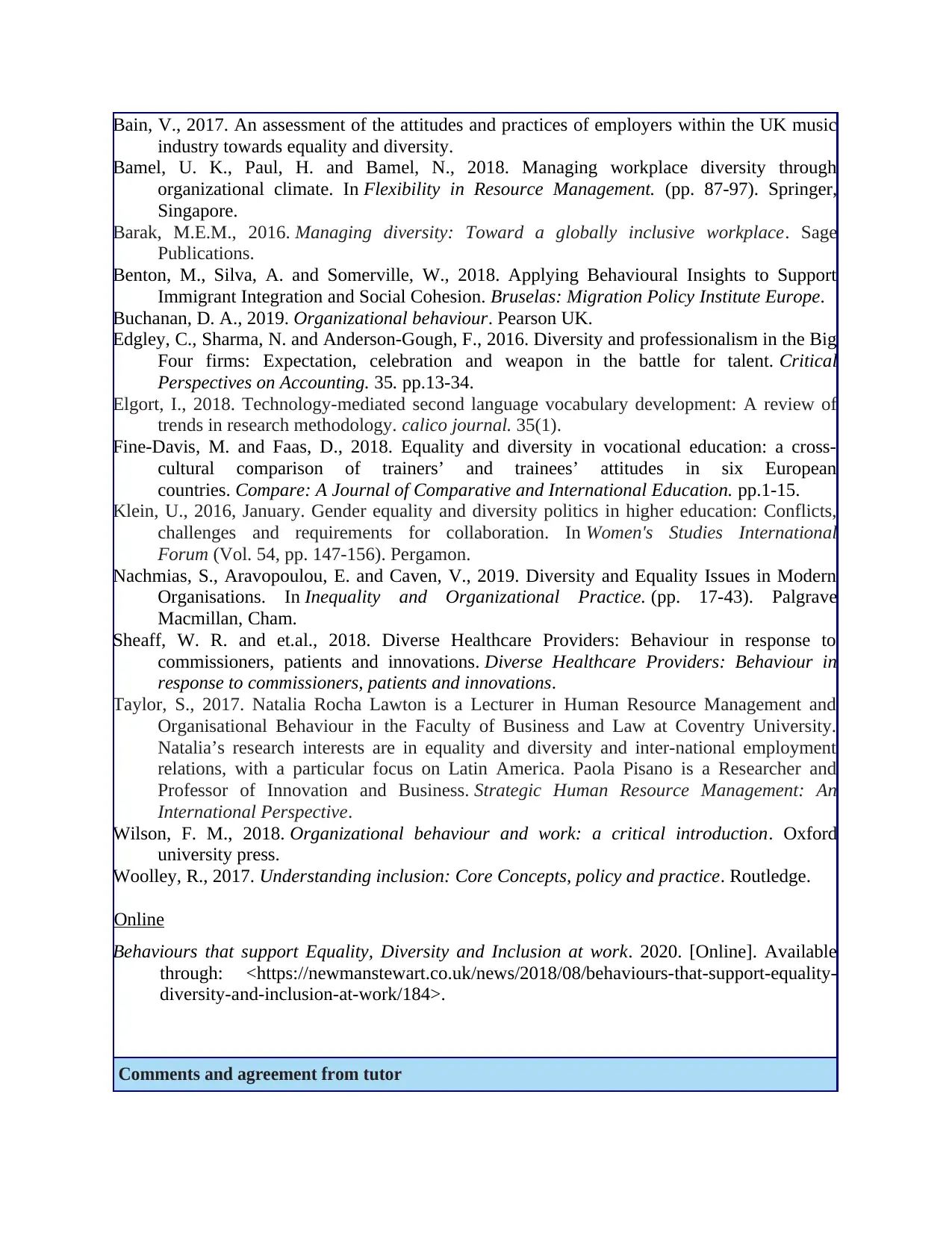
Bain, V., 2017. An assessment of the attitudes and practices of employers within the UK music
industry towards equality and diversity.
Bamel, U. K., Paul, H. and Bamel, N., 2018. Managing workplace diversity through
organizational climate. In Flexibility in Resource Management. (pp. 87-97). Springer,
Singapore.
Barak, M.E.M., 2016. Managing diversity: Toward a globally inclusive workplace. Sage
Publications.
Benton, M., Silva, A. and Somerville, W., 2018. Applying Behavioural Insights to Support
Immigrant Integration and Social Cohesion. Bruselas: Migration Policy Institute Europe.
Buchanan, D. A., 2019. Organizational behaviour. Pearson UK.
Edgley, C., Sharma, N. and Anderson-Gough, F., 2016. Diversity and professionalism in the Big
Four firms: Expectation, celebration and weapon in the battle for talent. Critical
Perspectives on Accounting. 35. pp.13-34.
Elgort, I., 2018. Technology-mediated second language vocabulary development: A review of
trends in research methodology. calico journal. 35(1).
Fine-Davis, M. and Faas, D., 2018. Equality and diversity in vocational education: a cross-
cultural comparison of trainers’ and trainees’ attitudes in six European
countries. Compare: A Journal of Comparative and International Education. pp.1-15.
Klein, U., 2016, January. Gender equality and diversity politics in higher education: Conflicts,
challenges and requirements for collaboration. In Women's Studies International
Forum (Vol. 54, pp. 147-156). Pergamon.
Nachmias, S., Aravopoulou, E. and Caven, V., 2019. Diversity and Equality Issues in Modern
Organisations. In Inequality and Organizational Practice. (pp. 17-43). Palgrave
Macmillan, Cham.
Sheaff, W. R. and et.al., 2018. Diverse Healthcare Providers: Behaviour in response to
commissioners, patients and innovations. Diverse Healthcare Providers: Behaviour in
response to commissioners, patients and innovations.
Taylor, S., 2017. Natalia Rocha Lawton is a Lecturer in Human Resource Management and
Organisational Behaviour in the Faculty of Business and Law at Coventry University.
Natalia’s research interests are in equality and diversity and inter-national employment
relations, with a particular focus on Latin America. Paola Pisano is a Researcher and
Professor of Innovation and Business. Strategic Human Resource Management: An
International Perspective.
Wilson, F. M., 2018. Organizational behaviour and work: a critical introduction. Oxford
university press.
Woolley, R., 2017. Understanding inclusion: Core Concepts, policy and practice. Routledge.
Online
Behaviours that support Equality, Diversity and Inclusion at work. 2020. [Online]. Available
through: <https://newmanstewart.co.uk/news/2018/08/behaviours-that-support-equality-
diversity-and-inclusion-at-work/184>.
Comments and agreement from tutor
industry towards equality and diversity.
Bamel, U. K., Paul, H. and Bamel, N., 2018. Managing workplace diversity through
organizational climate. In Flexibility in Resource Management. (pp. 87-97). Springer,
Singapore.
Barak, M.E.M., 2016. Managing diversity: Toward a globally inclusive workplace. Sage
Publications.
Benton, M., Silva, A. and Somerville, W., 2018. Applying Behavioural Insights to Support
Immigrant Integration and Social Cohesion. Bruselas: Migration Policy Institute Europe.
Buchanan, D. A., 2019. Organizational behaviour. Pearson UK.
Edgley, C., Sharma, N. and Anderson-Gough, F., 2016. Diversity and professionalism in the Big
Four firms: Expectation, celebration and weapon in the battle for talent. Critical
Perspectives on Accounting. 35. pp.13-34.
Elgort, I., 2018. Technology-mediated second language vocabulary development: A review of
trends in research methodology. calico journal. 35(1).
Fine-Davis, M. and Faas, D., 2018. Equality and diversity in vocational education: a cross-
cultural comparison of trainers’ and trainees’ attitudes in six European
countries. Compare: A Journal of Comparative and International Education. pp.1-15.
Klein, U., 2016, January. Gender equality and diversity politics in higher education: Conflicts,
challenges and requirements for collaboration. In Women's Studies International
Forum (Vol. 54, pp. 147-156). Pergamon.
Nachmias, S., Aravopoulou, E. and Caven, V., 2019. Diversity and Equality Issues in Modern
Organisations. In Inequality and Organizational Practice. (pp. 17-43). Palgrave
Macmillan, Cham.
Sheaff, W. R. and et.al., 2018. Diverse Healthcare Providers: Behaviour in response to
commissioners, patients and innovations. Diverse Healthcare Providers: Behaviour in
response to commissioners, patients and innovations.
Taylor, S., 2017. Natalia Rocha Lawton is a Lecturer in Human Resource Management and
Organisational Behaviour in the Faculty of Business and Law at Coventry University.
Natalia’s research interests are in equality and diversity and inter-national employment
relations, with a particular focus on Latin America. Paola Pisano is a Researcher and
Professor of Innovation and Business. Strategic Human Resource Management: An
International Perspective.
Wilson, F. M., 2018. Organizational behaviour and work: a critical introduction. Oxford
university press.
Woolley, R., 2017. Understanding inclusion: Core Concepts, policy and practice. Routledge.
Online
Behaviours that support Equality, Diversity and Inclusion at work. 2020. [Online]. Available
through: <https://newmanstewart.co.uk/news/2018/08/behaviours-that-support-equality-
diversity-and-inclusion-at-work/184>.
Comments and agreement from tutor
Paraphrase This Document
Need a fresh take? Get an instant paraphrase of this document with our AI Paraphraser

Comments (optional):
I confirm that the project is not work which has been or will be submitted for another qualification
and is appropriate.
Agreed: (date)
I confirm that the project is not work which has been or will be submitted for another qualification
and is appropriate.
Agreed: (date)
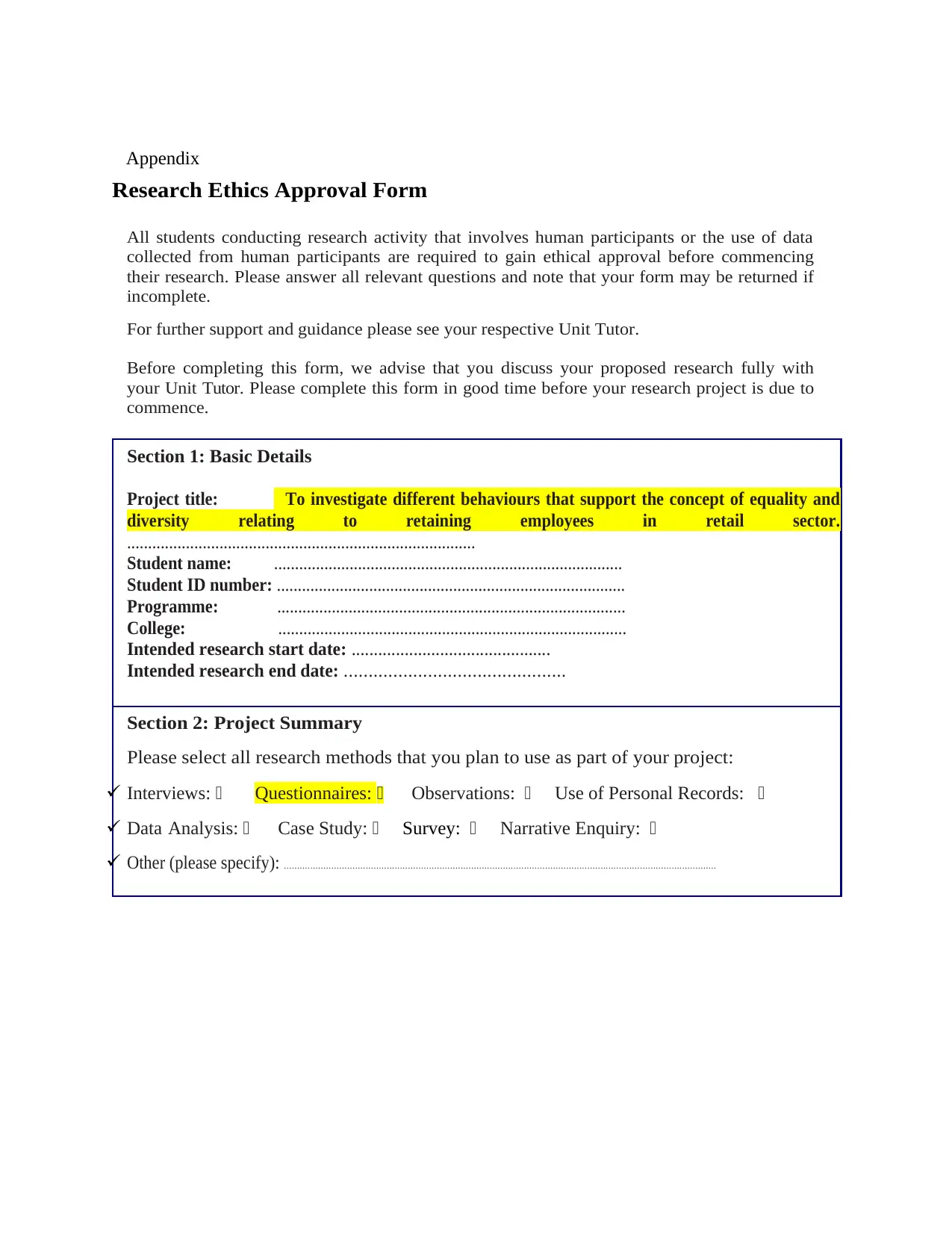
Appendix
Research Ethics Approval Form
All students conducting research activity that involves human participants or the use of data
collected from human participants are required to gain ethical approval before commencing
their research. Please answer all relevant questions and note that your form may be returned if
incomplete.
For further support and guidance please see your respective Unit Tutor.
Before completing this form, we advise that you discuss your proposed research fully with
your Unit Tutor. Please complete this form in good time before your research project is due to
commence.
Section 1: Basic Details
Project title: To investigate different behaviours that support the concept of equality and
diversity relating to retaining employees in retail sector.
...................................................................................
Student name: ...................................................................................
Student ID number: ...................................................................................
Programme: ...................................................................................
College: ...................................................................................
Intended research start date: .............................................
Intended research end date: .............................................
Section 2: Project Summary
Please select all research methods that you plan to use as part of your project:
Interviews: Questionnaires: Observations: Use of Personal Records:
Data Analysis: Case Study: Survey: Narrative Enquiry:
Other (please specify): ....................................................................................................................................................................
Research Ethics Approval Form
All students conducting research activity that involves human participants or the use of data
collected from human participants are required to gain ethical approval before commencing
their research. Please answer all relevant questions and note that your form may be returned if
incomplete.
For further support and guidance please see your respective Unit Tutor.
Before completing this form, we advise that you discuss your proposed research fully with
your Unit Tutor. Please complete this form in good time before your research project is due to
commence.
Section 1: Basic Details
Project title: To investigate different behaviours that support the concept of equality and
diversity relating to retaining employees in retail sector.
...................................................................................
Student name: ...................................................................................
Student ID number: ...................................................................................
Programme: ...................................................................................
College: ...................................................................................
Intended research start date: .............................................
Intended research end date: .............................................
Section 2: Project Summary
Please select all research methods that you plan to use as part of your project:
Interviews: Questionnaires: Observations: Use of Personal Records:
Data Analysis: Case Study: Survey: Narrative Enquiry:
Other (please specify): ....................................................................................................................................................................
⊘ This is a preview!⊘
Do you want full access?
Subscribe today to unlock all pages.

Trusted by 1+ million students worldwide
1 out of 15
Related Documents
Your All-in-One AI-Powered Toolkit for Academic Success.
+13062052269
info@desklib.com
Available 24*7 on WhatsApp / Email
![[object Object]](/_next/static/media/star-bottom.7253800d.svg)
Unlock your academic potential
Copyright © 2020–2025 A2Z Services. All Rights Reserved. Developed and managed by ZUCOL.





